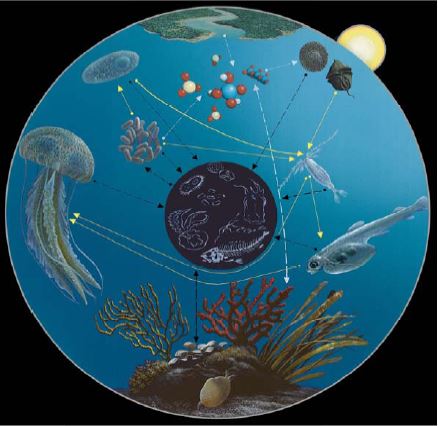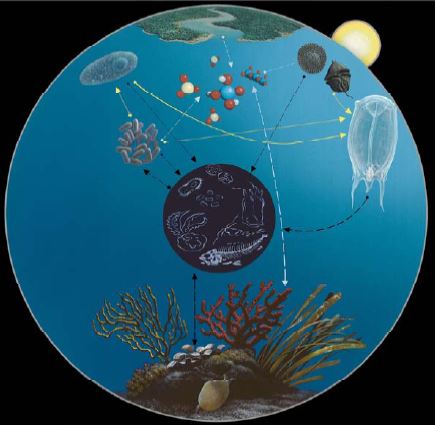1.3 Ecosystem “malfunctioning”
The term “malfunctioning” is obviously anthropocentric. All ecosystems do function, otherwise they would cease to exist. If they function so as to satisfy our expectations, they are considered as functioning well, whereas if they cease to do so, then they are labeled as functioning in a bad way (malfunction means just this: bad functioning).
Jellyfish are the oldest animals, among the ones that are currently present on the planet. They were present since the Pre-Cambrian and are not so different from their ancestors. Having passed through more than 500 millions of years of natural selection, with no big changes in their body organization, these animals are simply perfect! Simple and perfect. They also express their populations in pulses, like most of the representatives of marine systems. Jellyfish blooms, thus, are a quite normal phenomenon. The evolution of highly efficient animals, such as fish, however, probably posed a limit to their prevalence in the oceanic realm, with the triumph of the phytoplankton > herbivorous crustacean zooplankton > fish pathway that we like so much. A system based on pulses, however, is almost reset at each seasonal cycle. Such systems have been called “lottery systems” (see Boero, 1994; Fraschetti et al., 2003 for reviews). There is a “prize”, represented by the primary production pulse, and the winners are those who better utilize it, channeling its energy into their representatives, so as to build another pulse.
For the fish to be the winners, their larvae and juveniles must tap from the secondary production of crustaceans. Jellyfish compete with the fish larvae and juveniles for the use of this resource. Furthermore, they can also feed on the eggs and larvae of the fish. We have seen that jellyfish have life cycles with larval amplification (Fig. 1). They can be produced in great quantities, so as to rapidly build huge populations. Hence: jellyfish blooms.
The lottery game in marine systems is based on the match or mismatch of the secondary or tertiary producers with the pulses that are at the base of marine ecosystems (Cushing, 1990). If the jellyfish produce a pulse with a good match with the pulse of crustaceans, and the fish do not, then the jellyfish can take over, and their bloom is reinforced. The bloom of jellyfish will compete with the fish larvae
and juveniles and limit their growth, but it can also impact directly on the fish, since the blooming jellyfish will predate also on their eggs and larvae (Moller, 1984). When this happens, the phytoplankton > herbivorous crustacean zooplankton > fish pathway is disrupted, with the onset of the phytoplankton > herbivorous crustacean zooplankton > jellyfish pathway (Fig. 5).

Figure 5. The pathway phytoplankton > crustacean plankton > jellyfish (art by A. Gennari, graphics by F. Tresca).
The fish, however, can rely on their “internal” pathways and most of them can stand the failure of one cohort, since they are long lived and can spawn for several years. The loss of one cohort can be buffered by the adult individuals that, usually, are invulnerable to jellyfish or that even feed upon them. Jellyfish, instead, are short lived and the individuals that make up a single pulse cannot persist and must reproduce successfully, starting from scratch, to produce another pulse in the subsequent favorable season. Fish, instead, can “hold their breath” and try again a year later.
When systems work in this way, jellyfish blooms are “accidents” that do not disrupt in a radical way the functioning of the phytoplankton > herbivorous crustacean zooplankton > fish pathway. Hence they can be disregarded, as they have been so far by fisheries biologists. They have an impact, of course, but of limited entity.
The “jellyfish” considered here are the carnivorous ones, namely Cnidaria and Ctenophora. The same pattern can be present also for herbivorous jellyfish, namely the Chordata. They feed directly on the phytoplankton and when they are particularly abundant they compete with the copepods, depleting the phytoplankton > herbivorous crustacean zooplankton > fish pathway, with the production of a short circuit in it: the phytoplankton > herbivorous gelatinous zooplankton pathway (Fig. 6).
At the end of their peak, pelagic tunicates usually contribute to what we call marine snow and fall to the benthos, almost skipping the pelagic trophic pathways (besides the bacteria that feed on them while they are falling towards the bottom).

Figure 6. The pathway phytoplankton > herbivorous gelatinous zooplankton
(art by A. Gennari, graphics by F. Tresca).